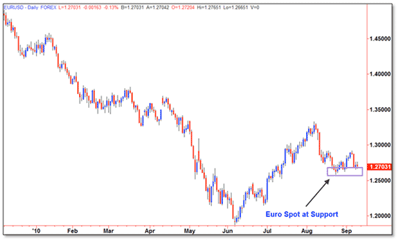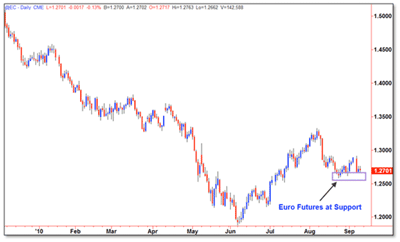As a part of the developed curriculum for the Online Trading Academy extended learning track (XLT) forex program, I have made it a point to introduce the ongoing students to all of the different ways to trade currency. When most of us think about the Forex markets, we typically focus our attention on the area of spot pairs trading. However, while the spot arena accounts for the vast majority of all currency trading in the world today, we should also be aware that this is not the only way for traders and investors to take part in this highly liquid and popular market. In fact, there are actually five different ways to trade forex available:
- Forex spot
- Forex futures
- Forex options
- Forex forwards
- Forex ETFs
This week, I will talk about the various aspects of forex spot and forex futures, which both combined account for around a third of all currency trading volume in the world today.
Forex Spot
Getting into the forex spot market is by far the most popular and accessible way to get involved, with a very large selection of pairs to trade. As well as all of the US dollar major pairings, we have a variety of cross pairs to choose from, including the likes of CAD/JPY, GBP/CHF, and EUR/AUD, to name just a few. Each trade is based on the dynamic of buying one pair while simultaneously selling another, or exchanging them, to put it another way. Anytime a trader takes a position, he or she is, in essence, long on one pair and short the other. To simplify this dynamic, it is easier to treat each pairing as a single instrument that we can choose to buy or sell, depending on our technical and fundamental analysis.
As well as enjoying an incredible level of liquidity in the spot market with no real danger of ever being stuck in a position, traders of forex spot can enjoy a huge choice of pairings to trade, many of which will offer some uniquely individual speculative opportunities at varying times due to the non-correlated aspects of the various currencies involved. It is rare for a trader of any style to be faced with circumstances where they are unable to find a decent trade that fits their plan. This abundance of liquidity (forex is a multi-trillion-dollar market) also makes the spot market the ideal place for taking large position sizes with a greater ease of execution, and the ability to get decent fills at a pre-determined price.
Margins are also relatively low due to the widely available 100:1 leverage, and this is especially attractive to traders of all skill levels as they are able to open trading accounts with as little as $100. It should be noted, however, that new legislation will soon be implemented into forex regulation which will reduce this leverage to between 50:1 and 20:1, depending on the pairing. While smaller than previously available leverage, this still offers some fantastic opportunities for traders and will offer a greater level of risk control across the board.
It should be remembered that the spot market also comes with a lack of regulation, too. Because there is no central marketplace due to the fact that price quotes are based on the interbank market, traders are forced to trade through forex broker markets, which closely track the main rates and offer a way for the rest of us to get involved. This setup means that we are actually trading the forex broker's market, they can see all of our orders on their system, and the broker creates the spread as well. While competition for clients forces brokers to maintain tight and consistent spreads, the savvy trader should always be fully aware of the mechanics surrounding the market they are trading and be fully aware that the unregulated nature of forex spot means that there is no exchange available to protect their trading capital should the broker go out of business. With this in mind, the majority of respected brokers out there will provide segregated accounts for their clients in a bid to offer the very best service available.
NEXT: Critical Aspects of Trading Forex Futures
|pagebreak|Forex Futures
The perception of the futures market is one of great risk and volatility, but this is mostly a common misunderstanding. With the right education and discipline, it can prove to be a highly lucrative market to participate in and will offer some of the greatest rewards and a much higher degree of safety if fully understood. A futures contract is an agreement between a buyer and seller to either deliver or purchase a pre-defined amount of an asset at a later date. If we are long a contract, we are agreeing to buy the asset for the current price with the obligation to take delivery of the product at a later date. If we are short a contract, we are agreeing to deliver the product at the current price at a later date. If one still holds the contract at expiry, then they are legally bound to either purchase or supply the asset depending on the trade taken. Now in the real world, we are never looking to actually buy or supply this product. We are just looking to profit from the movements in price, so the trader always needs to close their position before expiry. If they wish to enter the trade again, they can simply execute a position on the next contract month. Due to this dynamic, the futures market can be a little tricky to use for longer-term position and swing trades, and requires attention to when they expire, unlike the spot market, which continually rolls over.
However, these futures contracts make ideal intraday vehicles for the short-term trader and enjoy the benefits of direct market access with superior execution facilities, true market volume, price transparency, and fully secured accounts with the exchange backing them. With consistent one-tick spreads on all of the majors, this is the perfect market for the momentum trader, and leverage is still generous with between 20:1 and 50:1 available.
All prices in the currency futures are dictated by the current spot price, so trading is exactly the same. Below, we have charts of EUR/USD spot and the EUR/USD futures:
As we can see, prices at the same time are virtually the same, and technically, both markets are a mirror image of one another with both finding price support at the same time. It should be noted that unlike spot forex, where we can decide upon varying position sizes, futures contracts are standardized, making the smallest position size available for EC futures at 125,000 euro, or $12.50 per tick. This means that it is not the ideal starting point for the novice, but definitely a market for consideration at a more advanced stage of learning.
Hopefully I have introduced you to another way of considering forex trading. While it is one market, it has various ways to participate, and the seasoned trader or investor can benefit highly by using them all in the right way. Next week, we will continue our topic with a look into forex options, forwards, and ETFs.
By Sam Evans, instructor, OnlineTradingAcademy.com























